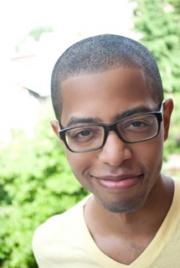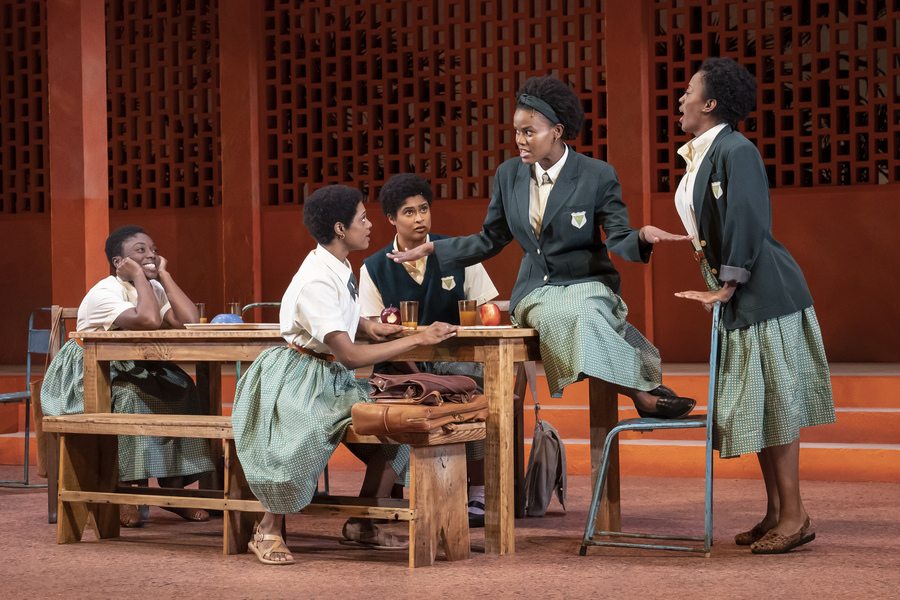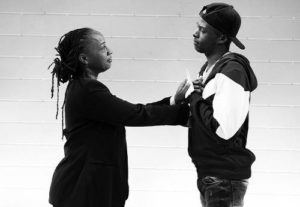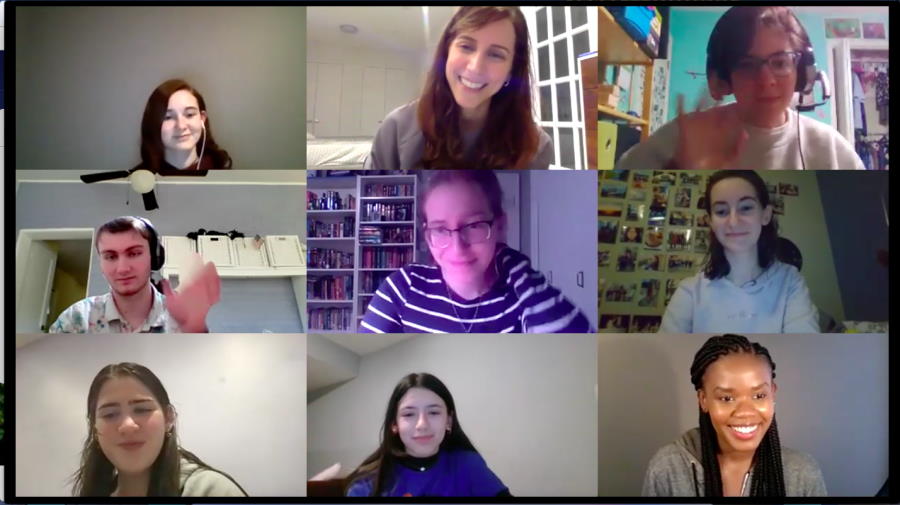Actress Ciera Dawn (she/her) entered the meeting for a virtual interview. It was a Thursday night and a group of high school students at Berman Academy in Maryland had gathered online to discuss Jocelyn Bioh’s play School Girls; Or, the African Mean Girls Play. Dawn had starred as Paulina in the School Girls production at Chicago’s Goodman Theatre and had accepted my invitation, as a teacher of the high school class, for a student interview session. A central character in the play, Paulina reigns as queen bee at her Ghanaian boarding school until a biracial transfer student, Ericka, arrives, complicating Paulina’s path to recruitment for the Miss Ghana pageant. What’s painful for Paulina is that she intuitively understands her limits in the presence of a light-skinned competitor.
Ariel Korkos (she/her), a biracial Berman student, had prepared a question for Dawn: “Why doesn’t Paulina embrace the beauty of her Blackness?”
“It’s a beautiful question,” Dawn responded. “To be taught to hate her Blackness and her African-ness—it’s heartbreaking. We don’t get to see what happens after the play in terms of reconciling and accepting her skin, but I like to believe she comes to that conclusion.”
Dawn’s visit was part of a virtual seminar for high school students I created last fall, focusing on two plays by acclaimed Black playwrights, Bioh’s School Girls and Dominique Morisseau’s Pipeline. I developed it as an extracurricular series that would involve reading, performance viewing (albeit virtually), scene study, and interviews with actors and directors who have brought each play to life. Titled the Theater Artists & Interviews Series: Exploring Black Narratives, the program began with the seed of an idea last summer, and has branched out to three high schools across the U.S., with several more on the horizon. My co-director, Kendell Pinkney (he/him), and I draw on our work in teaching, interviewing, theatremaking, and writing. He is Black, I am white, and both of us are Jewish. In our first year as partners in this program, we are focusing on Jewish schools across the United States.
In a recent conversation, I asked Kendell what a successful program would look like in his view. He hesitated to sum it up, because, he said, “It’s the least measurable thing. I want people to start seeing the various and sundry narratives of Black folks as complex, nuanced, non-monolithic, and deep in the way that they exactly are.”
Dawn offered a complementary thought following her session with the students. “My hope for schools in the United States is to give more attention and care to the arts so that all children can receive a strong arts and humanities education,” she said. “Within that, I would hope that Black and other BIPOC plays are in the forefront of the curriculum, replacing commonly taught playwrights that establish white men as the norm for narratives that are learned.”

During the Black Lives Matter protests last summer, there was much discussion around what it meant to be a genuine rather than a performative ally. Donations and volunteer efforts are essential, and I took part in several, but these felt pieced together, like they didn’t add up to enough impact. I wanted to be intentional and not scattershot with my engagement, to be an advocate using the skills I’ve developed. I began to think, what if I took two passions of my professional work—interviews and theatre analysis—and channeled them toward social justice?
The Black playwrights whose work I admire are masterful in their storytelling, their brilliant uses of structure, and their essential reflections on America, past and present: Morisseau, Bioh, Jacobs-Jenkins, Wilson, Nottage, Baldwin, Soyinka, Hansberry, Nwandu, Gurira, Parks. If I could bring these writers to classrooms, students, theatre clubs, English teachers, and administrators who want to foreground Black narratives but don’t know where to start, I might be able to add value. I kept returning to the thought that, second to friendship, storytelling is the most viable conduit toward learning and caring about other individuals, cultures, and communities. Art can change minds. If I am moved by these writers—by the diversity of their content and style—then I might be able to help others connect with their work as well.
My initial thought was to start in my own neighborhood of Crown Heights, Brooklyn. Perhaps I could begin at a nearby school or community organization. I asked a close friend who teaches arts education for her thoughts and she replied, “You could try that, but, if it’s a student program you’re after…didn’t you go to a Jewish high school? You might make more of an impact there.”
It wasn’t the direction I’d planned, but thinking over the idea, I realized the wisdom of her suggestion: to develop a program in a setting where I have a built-in layer of trust based on personal relationships and cultural familiarity. To foster growth, my friend advised, start in your own community.
In Jewish schools, there is continual discussion of the passage of our ancestors through history: how we persevered, how we endured, how we migrated (voluntarily and otherwise). Jewish education aims to foster a sense of peoplehood, shaped by the struggle for freedom by which we have prospered culturally and communally. This is an environment where Black narratives should find some affinity; Black writers, after all, chart similar experiences of exile, oppression, and deliverance beautifully and powerfully. There are sizable divides between Black communities and Jewish communities, obviously, notwithstanding key examples through history of relationship-building and advocacy among them. These divides, fueled by misunderstandings as much by both racism and anti-Semitism, are tragic missed opportunities for bridge-building, and can especially alienate Black Jews who feel connected to both communities.
Anti-Black racism dates back before our nation’s origins and persists in voter suppression, policing, housing, hiring, and healthcare discrimination, among other dimensions. While Jews have faced inarguable discrimination and violence in this country, most would agree that the United States has on balance been a haven for Jewish life. Even so, many Jews, based on a long history of ostracization that long precedes their time in this country, feel a certain wariness about taking their eyes off the road of their own security and interests. Studying Black narratives need not diminish that focus; instead it can offer a wider lens, a window into Black experiences, and a path toward closer connection.
I reached out to two Jewish schools in Maryland, both of which I attended while growing up in Silver Spring. In my pitch, I highlighted the interview component as a unique opportunity for students. School Girls and Pipeline seemed like the right choices for texts because, besides being nuanced and powerful plays, both portray the experiences of high school students. At the first Maryland school, the Charles E. Smith Jewish Day School, the program took shape as a semester-long club, offered weekly via Zoom. I reached out to actors who had performed in productions of both plays, and Jocelyn Bioh herself was generous in making introductions to several School Girls cast members. I invited three performers from School Girls—Mirirai Sithole, Joanna Jones, and Dawn—and two Pipeline actors, Justin Weaks from the Studio Theatre production in Washington, D.C., and Jaime Lincoln Smith from the Lincoln Center production in New York. I wanted the experience to be comfortable and welcoming for the artists, and made a commitment to pay each artist for every virtual visit. Following the School Girls sessions, I turned each interview into an episode of my podcast, Places Everyone, so that the conversations would have a longer life.
A friend then connected me to a third school, Shalhevet High School in Los Angeles. I proposed a similar extracurricular program, but then something interesting happened: The English teacher, Na’amit Nagel (she/her), watched the Lincoln Center performance of Pipeline, available on BroadwayHD, and wrote me an email to say, “I am thinking of teaching Pipeline to my 11th graders as a proper text. It is so rich.”
Rethinking syllabi to elevate Black voices is not new, but there has been an undeniable shift in the past nine months that has motivated teachers and administrators to push the idea toward fruition. Nagel suggested teaching the unit in tandem with me through virtual classroom sessions with guest artists. I was floored and delighted.
With three schools taking on the program, I felt energized if a bit confused about its direction. At the time, I was strategizing alone. I needed a thought partner, a Black theatre artist with whom to develop the program and help steer it forward. In December, I attended a virtual event that Kendell co-produced and moderated called “Art and Artists on Being Black and Jewish.” It was an inspiring event, and Kendell was an exceptionally skilled host. I had met him years prior, and the moment seemed auspicious to reconnect. We set up a Zoom call, expecting a casual conversation. After just 45 minutes, we made a plan to team up as co-directors.

Identity on the Line
At another Thursday night session with Berman Academy students, 12th grader Gabriella Fine (she/her) posed a question to guest artist Joanna Jones (she/her), “Do you think that acknowledging biracial identity is different in this play, set in Ghana, than in the United States?”
“That’s an amazing question,” Jones said.
Jones had starred in School Girls at New York City’s MCC Theater as Ericka, the American transfer student who moves to Ghana and finds that her light skin offers her a fast pass to stardom. In her American school, Ericka had felt excluded, but in Ghana, her appearance garners instant admiration and envy.
“I do think it’s different,” Jones said in response to the question, “especially in this play, which is set in the ’80s. In Ghana, the perception of a biracial person might be that they have so much privilege. Then Ericka comes in and says, ‘That’s not how it is in America.’ Being biracial in America is a confusing identity,” Jones continued, turning to her own experience. “You float through life feeling like an other a lot of the time. I appreciated the play bringing in that aspect—the American experience of being biracial.”
Gabriella nodded in her Zoom window. Scanning the other faces, I saw how well Jones’s responses held the students’ attention. It was new territory for most, but they were open to it, and the discussion encouraged them to ruminate on the idea of racial discrimination within a community. Certainly it exists within Jewish communities as well, where the vast majority are white and of Eastern European descent.
“I think the word ‘colorism’ will be new to some of the students,” Jones told me later on, “and yet I think a lot of them will come to realize after reading the play that they are already familiar with the concept. They can find examples of how Western standards of beauty in the media often exclude people with certain features that don’t meet the criteria. This is the perfect age for them to recognize that beauty comes in all shades and shapes, but most especially it comes from within.”
In our meetings, Kendell and I often discuss what we expect will be new to the students vs. what will be familiar. Our intention is to create a curated experience for schools that will meet students where they are while encouraging new exploration.
“So much of our identities feel like they’re on the line when we engage in matters of race and justice,” Kendell noted. “So how do we move forward in that compassionate sense while also moving toward a better reality? Art is the best tool to do that. The irony of art is that it gives us distance so we can speak to something in the truest sense.”
The narrative of Pipeline follows a public school teacher, Nya, who struggles to connect with her son Omari following a physical altercation between him and his teacher at a mostly white prep school. It’s about a world where young Black men feel cornered and belittled. Nya worries that the world sees Black boys as “too young, or too Black. Or too threatening. Or too loud…or too TOO.”
Actress Andrea Harris Smith (she/her), who starred as Nya in Studio Theatre’s production of Pipeline in Washington, D.C., visited two class sessions at Shalhevet, the L.A. school. Smith mentioned in her conversation with the students that she doesn’t share much overlap personally with Nya, and yet that very morning, she said she had overheard her son in Zoom class learning that Black youth are four times as likely to be arrested as white youth. Her son turned to her and asked, “Will that be me?” Instantly Smith’s connection to Nya was alive.
In a conversation afterward, Smith noted, “In my own experience encountering different cultures through stories, if the writing is good, a connection will be made. It’s really about having access to a variety of work and figuring out that universal themes happen in lots of different communities. A certain amount of dramaturgical work should accompany any text work. The collected dramaturgy we have on a classic like Death of a Salesman drops us straight into the social problems and suffering of those characters, so much that it’s a part of our own consciousness. Equal attention paid to dramaturgy—context, societal bias, statistical evidence—in a play like Pipeline allows for much greater understanding and hopefully empathy. The more specific you get about showing an experience in a play, the more one’s ability to relate grows exponentially.”
In a video that appears in the Lincoln Center Theater website’s resource section on Pipeline, Morisseau relays an anecdote about her mother, a public school teacher, to whom Pipeline is dedicated. She recalls how her mother responded when a student shouted an insult at her in class. Morisseau expected her mother to be upset by the student’s disrespect, but her mother explained that the child was having difficulty at home and that it’s essential for teachers “to see that kids come to school as whole human beings and they’re not compartmentalized. This is a story about a kid who has been compartmentalized,” Morisseau says of Pipeline. “His humanity has been compartmentalized.”
The impact of Pipeline on Shalhevet’s students came through in their response papers. One student, 11th grader Jonah Ackerman (he/him), wrote about a scene in which Nya teaches Gwendolyn Brooks’s poem “We Real Cool”, highlighting the way Brooks breaks up the “We” in each line. Nya tells her class that Brooks’s broken phrasing is intentional. “The font looks like graffiti writing,” Nya says, “not what we normally see in our textbooks…it doesn’t get the same respect.”
“Nya here is teaching her students the ‘broken’ poem,” Ackerman wrote. “She teaches them a lesson that even if there are people who treat them unfairly and unjustly that they should never be discouraged. She compares this to how there is no such thing as broken poetry. Every person should be treated with dignity and respect no matter how different, unique or ‘broken.’”
When I asked Nagel, the Shalhevet teacher, what made her decide to revise her curriculum in the middle of a school year to teach Pipeline, she replied, “The heart of what we’re doing in education is trying to teach teenagers to be moral, kind human beings. You watch a play like this and think, This will get them to see an American reality that in their bubble they may not have witnessed. Watching and discussing Pipeline can give them a much-needed window into a different reality that’s also, importantly, not so different from themselves.”
Jones had a similar perspective on School Girls.

“I think that the intentional inclusion of more literature by Black authors and playwrights is an important and necessary goal to strive toward,” she told me. “School Girls is a perfect piece to bring to high school students because there are universal themes in it that they can relate to. The students don’t have to be biracial or the new kid in town like Ericka’s character to understand what it feels like to be singled out for being different. We all know what it felt like to be in high school, to be terrified of being made fun of, of not fitting in, or being accepted as we are.”
That element of universality is how we all connect to stories. Yet the most compelling writers are deeply specific. To read Pipeline and only see its universal theme of motherly love would be to miss the story’s core. After Omari’s teacher isolates him as the class’s only Black student to the extent that he physically pushes back, his mother Nya is overcome with worry but not yet ready to hear his side. She knows the school administrators will see the outcome of the incident, not the buildup; they’ll see Omari’s skin and react accordingly harshly. That experience is not universal. In addition to evoking universal feelings, art also has a unique ability to portray the dehumanizing specifics of inequity in our time.
In the final session with Berman Academy, director Awoye Timpo (she/her), who helmed the production of Pipeline at Studio Theatre, led a director’s workshop with the students, focusing on select pages in the Nya/Omari scene. The students related to certain facets intuitively, such as the challenge of honest communication between parents and teenagers. Those perceptions are essential, but, as Timpo noted, “The thing that makes this scene so compelling (and feel so richly drawn) is the beautiful and harrowing specificity and love in this mother/son relationship.”
Kendell calls this “the encounter”—the ability for stories to lead us into people’s specific experiences. The encounter “meets us where we are,” Kendell says, “and then it leads us somewhere. Sometimes the encounter is planned, sometimes it is a surprise. Regardless, it requires something of us: a recognition, a response, an action.” That is our intention in teaching Black narratives and in expanding curricula: to facilitate encounter after encounter.
Lonnie Firestone (she/her) is the co-director of Exploring Black Narratives. She hosts the podcast Places Everyone.


